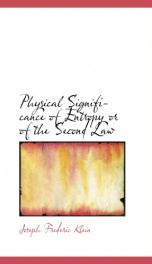physical significance of entropy or of the second law

Purchase of this book includes free trial access to www.million-books.com where you can read more than a million books for free. This is an OCR edition with typos. Excerpt from book: magnitudes. For the micro-observer, the state and the sequence of the event would not be determined until all these many magnitudes had been separately given. The state thus denned we will call the "micro-state." The macroscopic-observer on the other hand gets along with much fewer data; he will say that the state of the contemplated homogeneous gas is already determined by the density, the visible velocity and the temperature at each place of the gas and he will expect, when these magnitudes are given, that the course of the physical events will be completely determined, namely, will occur jn obedience to the two laws of thermodynamics and therefore be bound to show an increase in entropy. The state thus denned we will call the "macro-state." The difference in the two observers is that one sees only the atomic events and the other the occurences in the aggregate. The former would have the absolute mechanical idea of state and the latter the statistical idea. Before attempting to reconcile their apparently conflicting conclusions, we will here call attention to some necessary relations between the micro-state and the macro-state. In the first place we must remember that all a priori possible micro-states are not realized in nature; they are conceivable but never attain fruition. How shall we select what may be called these natural micro-states? The principles of general dynamics furnish no guide for such selection and so recourse may be had to any dynamic hypothesis whose selection will be fully justified by experience. Now Planck says: " In order to traverse this path of investigation, we must evidently first of all keep in mind all the conceivable positions and velocities of the individual atoms, which are compatible with particular values of the density, the velocity and the... --This text refers to the Paperback edition.
Info about the book
Author:
Series:
Unknown
ASIN:
B007BNK2KW
Rating:
2.5/5 (4)Your rating:
0/5
Languge:
English
Users who have this book
Users who want this book
What readers are saying
What do you think? Write your own comment on this book!
write a commentGenre
if you like physical significance of entropy or of the second law try:
Do you want to exchange books? It’s EASY!
Get registered and find other users who want to give their favourite books to good hands!


